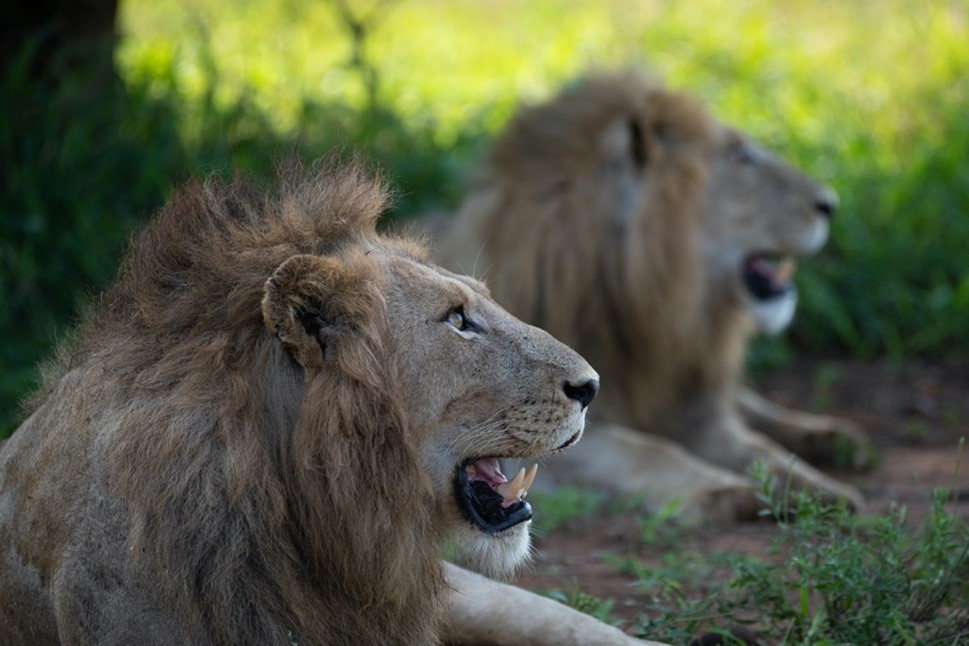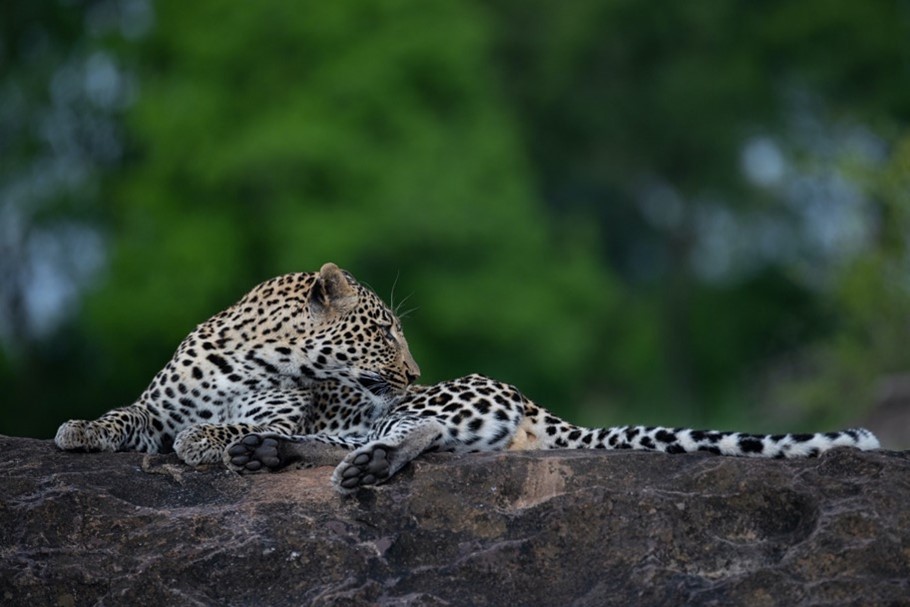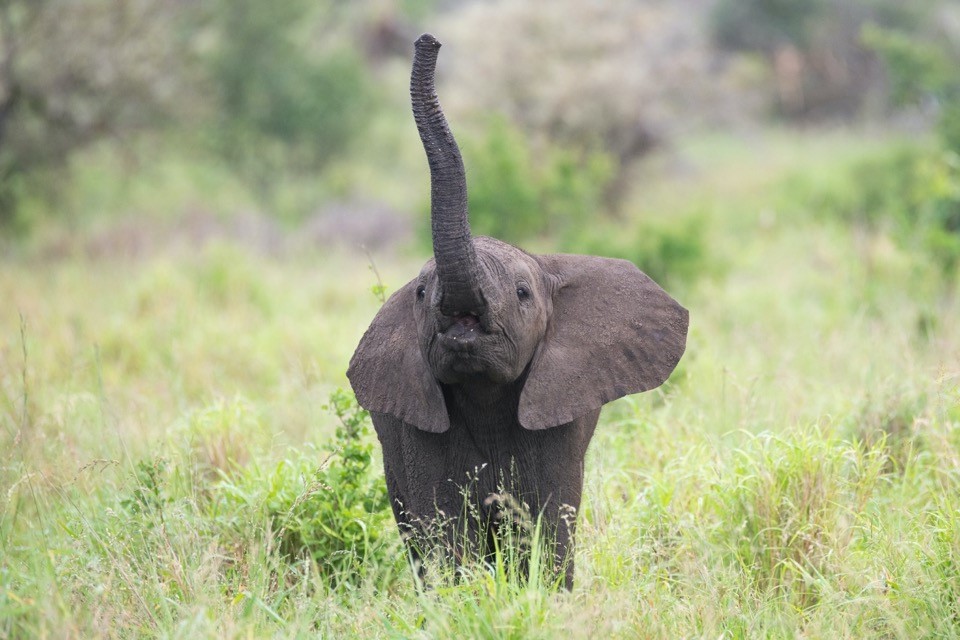January 2023
Singita Kruger National Park: January 2023
Share:
Singita Kruger National Park: January 2023
The month of January saw very little rain arrive in the south with most of the rain falling in the north. A few of the watering holes and mud wallows in the central depression are still full from December rainfall but we are most certainly still in need of more for the N’wanetsi and Sweni Rivers to hold water through the year. More migratory bird species returned from their northern adventures, and marula trees have started fruiting. Pops of colours are seen throughout the concession with multiple trees and wild flowers in bloom.
A Sightings Snapshot for January follows:
Lions
January started with immense excitement when a coalition of five males were found in the north along Nkayanini. These males have previously been seen on Mbatsane (our northern border) but this was the first time they had been located within the concession. They stayed for two days before making their way back north. Signs of their presence were found again one morning when a devoured buffalo carcass was located with multiple sets of male lion tracks around the carcass leading us to believe that these five males were the likely culprits.
The larger portion of the Mananga Pride have, to a degree, vacated the north and central parts that they were commonly seen in before. They have spent the majority of their time to the west of the concession and were even seen all the way south along the H6 public road. Previously this prides movements centred around the presence of buffalo herds which have been frequenting the central depression and north thereof. We think their dispersal may have something to do with the incursion of the five males moving in from the north.
The smaller portion of the Mananga Pride have been infrequently viewed with them spending the majority of the month west of the concession. They have been seen mostly along Park Road and once on a zebra kill in the clearings east of Gudzani Dam. One morning, however, surprised us all when the pride along with the Shishangaan males were found just north of a crossing that is very far south and east of where this pride normally occurs. We viewed the entire complement of the Mananga Pride one afternoon when the larger portion responded to calls from the smaller portion.
The Shishangaan males are spending a lot of time with the smaller portion of the Mananga Pride and are not often seen on their own. This aging coalition are still holding firm for now and were even found one morning heading back north from an area that the two Trichardt males were found in. No signs of a confrontation were observed but it is still commendable that these males must have headed south initially to follow up on the Trichardt males who were vocalizing the evening before.
Four sightings of the Shishangaan Pride were had in January with four lionesses being viewed on each occasion and all in close proximity to the lodges. It’s thought that the pride moved further south and east, and potentially into Mozambique, due to the three large males that have been challenging the Trichardt males.
The Trichardt males have kept a low profile and there were initial thoughts that the coalition had been pushed out. This was until one morning when the two males were found just east of the lodges, in excellent condition. The three nomadic males haven’t been seen this month and so the pressure seems to be off the Trichardt males for the time being.
The Maputo male has been seen on a few occasions in the central parts of the property, vocalizing and marking his former territory.

Leopards
Two of the large male leopards that we view were named this month. One male, which holds territory from the sticky-thorns northwards to Double Crossing and then from Basalt and further west, was named the ‘Pelajambu male’ which roughly means ‘where the sun sets’ owing to this male’s territory being in the west. The other male is a very relaxed individual who has been viewed on the concession for some time but was never named for recording purposes. This male’s territory is large and stretches from west of the concession to as far east as Nyokene. He has been called the ‘Monzo male’, the Xitsonga word for leadwood tree as he has been seen resting in leadwood trees on a few occasions and has been sighted moving along Monzo Road.
The Nhlanguleni female is doing an incredible job at providing meals for her two cubs, and the trio were located on three separate kills throughout the month. The cubs are becoming more habituated to vehicles and are extremely relaxed when mom is around.
The Dumbana young males are continuing to spend time within their natal area and are still often found along Ntsibitsane and Ostrich-link. The Dumbana 3:3 young male was seen more than his paler brother and he was even seen as far north as Ingwe/2-tegwaan where he spent a few days moving along the Xinkelengane drainage before returning back south. The brothers were seen together one day where they lay in close proximity to each other around a small pan of water. Their mother was seen once this month and is looking very pregnant. She was seen exploring the ridge line to the north of Madagha crossing, potentially looking for a den-site.
An unknown skittish female and her cub were seen on Park Road south of James. Tracks of these two have been seen on the concession and this was the first sighting of the pair.

Wild dogs
Sightings of African wild dogs have continued to enthral both guides and guests throughout the month. We’ve enjoyed quality viewing of two different packs, a pack of nine, and eleven.
Both packs have been sighted in very similar areas in the mountains east of the N’wanetsi River as well as in the open clearings around Ostrich Link.
One morning, guides were able to follow the pack of nine for almost the entire morning around Ntsibitsane and Ostrich Link where they gave chase to multiple impala herds and were successful in bringing down two adult impalas.
Some guides and their guests had the incredible opportunity to observe the collaring of one of the wild dogs from the pack of nine. This initiative is run by the Mpumalanga State Veterinarians and African wild dog specialists from the Endangered Wildlife Trust. African wild dogs are free roamers and move over incredible distances, and the packs that we have the opportunity of viewing also cross over into Mozambique. The satellite collar allows the research teams to keep track of the packs movements.
Spotted hyenas
A number of spotted hyenas have been viewed around Ma-4-Pounds, Monzo, Ntsibitsane and Ostrich Link open area. They are often found in the small wallows, escaping the heat and enjoying the cooler water and mud.
A clan of five were sighted following the pack of nine wild dogs and were quickly rebuffed when they tried to rob the pack of their two impala kills.
Elephants
Many of the herds and bulls have moved further west to the granitic soils, where marula trees are more prevalent. These trees are now fruiting and its these fruits that the large pachyderms absolutely crave around this time of the year.
Most sightings of breeding herds are in the central depression where a number of seasonal watering holes and mud wallows are found and it is around these wallows that the elephants can be found in the afternoons.
A very memorable sighting of a true Kruger Tusker bull, with tusks stretching to just above the ground, was had one morning. He calmly strolled down one of the roads to a mud wallow before moving west to the edges of the concession. He must be one of the well-known tuskers in the park and photographs of him will be sent to the necessary personnel for identification purposes.

Buffalos
We have enjoyed regular sightings of at least two large herds of buffalo all throughout the central and northern sections of the concession. The one herd numbers ± 250 animals and the other is between 400 – 500 buffalos. The herds are often found in areas with multiple mud wallows where they can be observed rolling around and covering themselves in the dark coloured mud.
A few buffalo bulls were sighted along the N’wanetsi River often around Xingwenyana and Dave’s Crossing.
Plains game
We have once again been spoilt with regular incredible sightings of giraffes all throughout the concession. All the wildebeest herds have multiple young calves with some late arrivals having been born in the latter parts of January. Dazzles of plains zebras are found in various parts of the concession with one very memorable sighting where over 150 zebras were seen together! Waterbuck are seen all along the N’wanetsi River and are found in large herds around Gudzani Dam.
Cheetahs
The female cheetah and two sub-adults were spotted twice this month moving through the central depression. Over a year old now, the time is fast approaching where the two young males will have to fend for themselves.
A single female cheetah was seen around Leadwood/Xinkelengane where she was observed chasing a family of warthogs before hunting and successfully killing a common duiker. Guests then watched a second female the following day chase and kill an impala lamb on Gudzani loop.
Rare animals and other sightings
Serval were viewed four times this month including one very relaxed individual around N’wanetsi Big Bend with which guests were able to spend significant time.
Birds
Blue-cheeked bee-eaters were sighted around Puffadder Pools.
Southern carmine bee-eaters are being seen across the concession with most sightings around the Central Depression.
A white-fronted bee-eater was sighted at Xingwenyana Crossing.
A Eurasian hobby was sighted along Ntsibitsane.
Amur falcons have been seen hawking termite alates in the grasslands.
A dwarf bittern was seen in a marsh area around Double Crossing.

By Jenny Hishin
Author / Field Guide